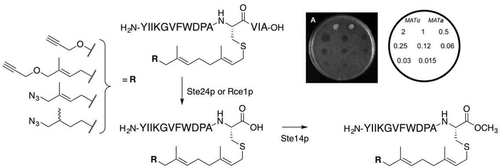当前位置:
X-MOL 学术
›
Bioconjugate Chem.
›
论文详情
Our official English website, www.x-mol.net, welcomes your
feedback! (Note: you will need to create a separate account there.)
a-Factor Analogues Containing Alkyne- and Azide-Functionalized Isoprenoids Are Efficiently Enzymatically Processed and Retain Wild-Type Bioactivity.
Bioconjugate Chemistry ( IF 4.0 ) Pub Date : 2017-12-20 , DOI: 10.1021/acs.bioconjchem.7b00648 Veronica Diaz-Rodriguez 1 , Erh-Ting Hsu 2 , Elena Ganusova 3 , Elena R Werst 1 , Jeffrey M Becker 3 , Christine A Hrycyna 2 , Mark D Distefano 1
Bioconjugate Chemistry ( IF 4.0 ) Pub Date : 2017-12-20 , DOI: 10.1021/acs.bioconjchem.7b00648 Veronica Diaz-Rodriguez 1 , Erh-Ting Hsu 2 , Elena Ganusova 3 , Elena R Werst 1 , Jeffrey M Becker 3 , Christine A Hrycyna 2 , Mark D Distefano 1
Affiliation

|
Protein prenylation is a post-translational modification that involves the addition of one or two isoprenoid groups to the C-terminus of selected proteins using either farnesyl diphosphate or geranylgeranyl diphosphate. Three crucial enzymatic steps are involved in the processing of prenylated proteins to yield the final mature product. The farnesylated dodecapeptide, a-factor, is particularly useful for studies of protein prenylation because it requires the identical three-step process to generate the same C-terminal farnesylated cysteine methyl ester substructure present in larger farnesylated proteins. Recently, several groups have developed isoprenoid analogs bearing azide and alkyne groups that can be used in metabolic labeling experiments. Those compounds have proven useful for profiling prenylated proteins and also show great promise as tools to study how the levels of prenylated proteins vary in different disease models. Herein, we describe the preparation and use of prenylated a-factor analogs, and precursor peptides, to investigate two key questions. First, a-factor analogues containing modified isoprenoids were prepared to evaluate whether the non-natural lipid group interferes with the biological activity of the a-factor. Second, a-factor-derived precursor peptides were synthesized to evaluate whether they can be efficiently processed by the yeast proteases Rce1 and Ste24 as well as the yeast methyltransferase Ste14 to yield mature a-factor analogues. Taken together, the results reported here indicate that metabolic labeling experiments with azide- and alkyne-functionalized isoprenoids can yield prenylated products that are fully processed and biologically functional. Overall, these observations suggest that the isoprenoids studied here that incorporate bio-orthogonal functionality can be used in metabolic labeling experiments without concern that they will induce undesired physiological changes that may complicate data interpretation.
中文翻译:

包含炔和叠氮基官能化类异戊二烯的α因子类似物经过高效酶处理并保留了野生型生物活性。
蛋白质异戊二烯化是翻译后修饰,涉及使用法呢基二磷酸酯或香叶基香叶基二磷酸酯基将一个或两个类异戊二烯基团添加到所选蛋白质的C末端。三个重要的酶促步骤涉及到异戊二烯化蛋白的加工过程中,以产生最终的成熟产物。法呢基化十二肽,a因子,对于蛋白质异戊二烯化的研究特别有用,因为它需要相同的三步过程才能生成较大法呢基化蛋白中存在的相同的C端法呢基化半胱氨酸甲酯亚结构。最近,几个小组开发了带有叠氮化物和炔烃基团的类异戊二烯类似物,可用于代谢标记实验。那些化合物已被证明可用于分析异戊二烯化蛋白,并且作为研究异戊二烯化蛋白水平在不同疾病模型中如何变化的工具也显示出巨大的希望。在本文中,我们描述了异戊二烯化α-因子类似物和前体肽的制备和使用,以研究两个关键问题。首先,制备含有修饰的类异戊二烯的α-因子类似物以评估非天然脂质基团是否干扰α-因子的生物学活性。第二,合成α-因子衍生的前体肽,以评估它们是否可以被酵母蛋白酶Rce1和Ste24以及酵母甲基转移酶Ste14有效加工以产生成熟的α-因子类似物。在一起 此处报道的结果表明,使用叠氮化物和炔烃官能化的类异戊二烯进行的代谢标记实验可以产生经过充分加工和具有生物学功能的异戊烯化产品。总体而言,这些观察结果表明,此处研究的结合了生物正交功能的类异戊二烯可用于代谢标记实验,而无需担心它们会引起不希望的生理变化,从而可能会使数据解释复杂化。
更新日期:2017-12-20
中文翻译:

包含炔和叠氮基官能化类异戊二烯的α因子类似物经过高效酶处理并保留了野生型生物活性。
蛋白质异戊二烯化是翻译后修饰,涉及使用法呢基二磷酸酯或香叶基香叶基二磷酸酯基将一个或两个类异戊二烯基团添加到所选蛋白质的C末端。三个重要的酶促步骤涉及到异戊二烯化蛋白的加工过程中,以产生最终的成熟产物。法呢基化十二肽,a因子,对于蛋白质异戊二烯化的研究特别有用,因为它需要相同的三步过程才能生成较大法呢基化蛋白中存在的相同的C端法呢基化半胱氨酸甲酯亚结构。最近,几个小组开发了带有叠氮化物和炔烃基团的类异戊二烯类似物,可用于代谢标记实验。那些化合物已被证明可用于分析异戊二烯化蛋白,并且作为研究异戊二烯化蛋白水平在不同疾病模型中如何变化的工具也显示出巨大的希望。在本文中,我们描述了异戊二烯化α-因子类似物和前体肽的制备和使用,以研究两个关键问题。首先,制备含有修饰的类异戊二烯的α-因子类似物以评估非天然脂质基团是否干扰α-因子的生物学活性。第二,合成α-因子衍生的前体肽,以评估它们是否可以被酵母蛋白酶Rce1和Ste24以及酵母甲基转移酶Ste14有效加工以产生成熟的α-因子类似物。在一起 此处报道的结果表明,使用叠氮化物和炔烃官能化的类异戊二烯进行的代谢标记实验可以产生经过充分加工和具有生物学功能的异戊烯化产品。总体而言,这些观察结果表明,此处研究的结合了生物正交功能的类异戊二烯可用于代谢标记实验,而无需担心它们会引起不希望的生理变化,从而可能会使数据解释复杂化。











































 京公网安备 11010802027423号
京公网安备 11010802027423号